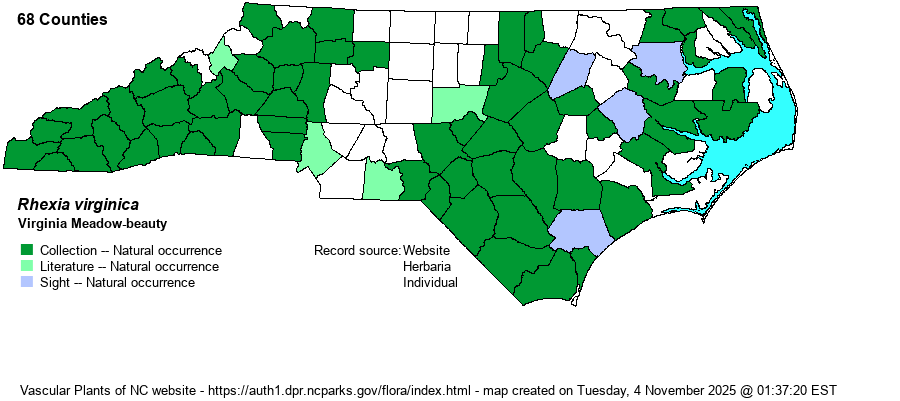| Author | L. | |
| Distribution | A two-part range in the state, occurring over essentially all of the Coastal Plain and eastern Piedmont, and then also in the Mountains and western Piedmont. It is absent in the middle 40% of the Piedmont.
This is a very widespread Eastern species, ranging from eastern Canada south to northern FL and eastern TX. It is mostly absent in much of the Piedmont from NC to SC and GA, for no obvious reason. | |
| Abundance | Common in the southern third of the Coastal Plain, including the Sandhills region, and fairly common in the adjacent eastern Piedmont. Infrequent over much of the central and northern Coastal Plain, outnumbered there by R. nashii and R. mariana. Frequent to common in the southern Mountains and parts of the western Piedmont, but scarce in the northern mountains. Very rare to absent in much of the central Piedmont. | |
| Habitat | This is a wetland species that has a wide array of habitats, generally away from pineland savannas. It grows in marshes, ditches, wet streamhead pocosins, openings in bottomlands and swamps, margins of ponds and pools, and other similar sites. | |
| Phenology | Blooms from May to October, and fruits shortly after flowering. | |
| Identification | This is a familiar and often seen Rhexia, quite hairy overall and typically with a few branches. It reaches about 2-2.5 feet tall, and has its mid-stem region consisting of 4 flat surfaces of equal size and flatness (compared with unequally flattened as in R. mariana and R. nashii). In this species, the edges are somewhat winged, as compared with no wings on the edges in R. ventricosa. The paired leaves are elliptic to ovate, about 2-3 inches long and about 3/4-inch wide, usually ascending, with small serrations along the margins. The flowers are typical for the genus, consisting of a handful of them from upper leaf axils and stem tips, with the 4 petals being bright rose to less often rose-pink, and the flower being about 1.5 inches across. R. virginica has the roots with tubes or spongy-thickened, versus none of these for R. ventricosa. Thus, separation of these two species can be troubling, and both can occur in the same regions and wetland habitats. In general, the petals of this species are more deeply rose-colored than are those in R. ventricosa, which generally has a more of a rose-pink color. | |
| Taxonomic Comments | Some references list varieties of this species, but Weakley (2018) does not.
| |
| Other Common Name(s) | Wingstem Meadow-beauty, Handsome Harry | |
| State Rank | S5 | |
| Global Rank | G5 | |
| State Status | | |
| US Status | | |
| USACE-agcp | FACW link |
| USACE-emp | OBL link |

